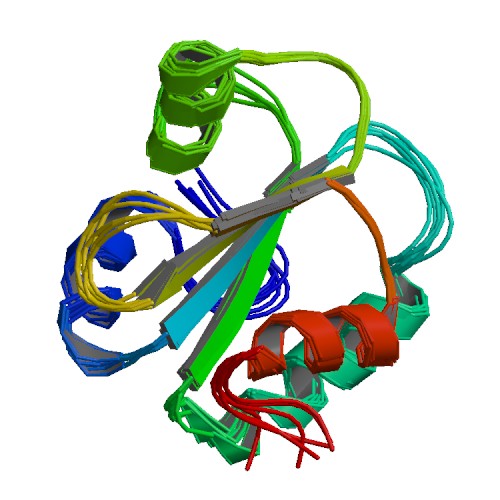ERP29
| Endoplasmic reticulum protein 29 | |||||||||||||
|---|---|---|---|---|---|---|---|---|---|---|---|---|---|
 PDB rendering based on 1g7e. | |||||||||||||
| |||||||||||||
| Identifiers | |||||||||||||
| Symbols | ERP29 ; C12orf8; ERp28; ERp31; PDI-DB | ||||||||||||
| External IDs | Template:OMIM5 Template:MGI HomoloGene: 4963 | ||||||||||||
| |||||||||||||
| RNA expression pattern | |||||||||||||
 | |||||||||||||
| More reference expression data | |||||||||||||
| Orthologs | |||||||||||||
| Template:GNF Ortholog box | |||||||||||||
| Species | Human | Mouse | |||||||||||
| Entrez | n/a | n/a | |||||||||||
| Ensembl | n/a | n/a | |||||||||||
| UniProt | n/a | n/a | |||||||||||
| RefSeq (mRNA) | n/a | n/a | |||||||||||
| RefSeq (protein) | n/a | n/a | |||||||||||
| Location (UCSC) | n/a | n/a | |||||||||||
| PubMed search | n/a | n/a | |||||||||||
Endoplasmic reticulum protein 29 (ERp29) is a human chaperone protein. ERP29 is the human gene encoding it.[1]
Gene
This gene encodes a reticuloplasmin, a protein which resides in the lumen of the endoplasmic reticulum (ER). The protein shows sequence similarity to the protein disulfide isomerase family. However, it lacks the thioredoxin motif characteristic of this family, suggesting that this protein does not function as a disulfide isomerase. The protein dimerizes and is thought to play a role in the processing of secretory proteins within the ER. Alternative splicing results in multiple transcript variants encoding different isoforms.[1]
References
Further reading
- Hubbard MJ (2003). "Functional proteomics: The goalposts are moving". Proteomics. 2 (9): 1069–78. doi:10.1002/1615-9861(200209)2:9<1069::AID-PROT1069>3.0.CO;2-R. PMID 12362325.
- Mkrtchian S, Sandalova T (2006). "ERp29, an unusual redox-inactive member of the thioredoxin family". Antioxid. Redox Signal. 8 (3–4): 325–37. doi:10.1089/ars.2006.8.325. PMID 16677078.
- Hochstrasser DF, Frutiger S, Paquet N; et al. (1993). "Human liver protein map: a reference database established by microsequencing and gel comparison". Electrophoresis. 13 (12): 992–1001. PMID 1286669.
- Hughes GJ, Frutiger S, Paquet N; et al. (1994). "Human liver protein map: update 1993". Electrophoresis. 14 (11): 1216–22. PMID 8313870.
- Mkrtchian S, Fang C, Hellman U, Ingelman-Sundberg M (1998). "A stress-inducible rat liver endoplasmic reticulum protein, ERp29". Eur. J. Biochem. 251 (1–2): 304–13. PMID 9492298.
- Ferrari DM, Nguyen Van P, Kratzin HD, Söling HD (1998). "ERp28, a human endoplasmic-reticulum-lumenal protein, is a member of the protein disulfide isomerase family but lacks a CXXC thioredoxin-box motif". Eur. J. Biochem. 255 (3): 570–9. PMID 9738895.
- Hubbard MJ, McHugh NJ (2001). "Human ERp29: isolation, primary structural characterisation and two-dimensional gel mapping". Electrophoresis. 21 (17): 3785–96. doi:10.1002/1522-2683(200011)21:17<3785::AID-ELPS3785>3.0.CO;2-2. PMID 11271497.
- Shnyder SD, Hubbard MJ (2002). "ERp29 is a ubiquitous resident of the endoplasmic reticulum with a distinct role in secretory protein production". J. Histochem. Cytochem. 50 (4): 557–66. PMID 11897809.
- Sargsyan E, Baryshev M, Backlund M; et al. (2002). "Genomic organization and promoter characterization of the gene encoding a putative endoplasmic reticulum chaperone, ERp29". Gene. 285 (1–2): 127–39. PMID 12039039.
- Strausberg RL, Feingold EA, Grouse LH; et al. (2003). "Generation and initial analysis of more than 15,000 full-length human and mouse cDNA sequences". Proc. Natl. Acad. Sci. U.S.A. 99 (26): 16899–903. doi:10.1073/pnas.242603899. PMID 12477932.
- Basrur V, Yang F, Kushimoto T; et al. (2003). "Proteomic analysis of early melanosomes: identification of novel melanosomal proteins". J. Proteome Res. 2 (1): 69–79. PMID 12643545.
- Gerhard DS, Wagner L, Feingold EA; et al. (2004). "The status, quality, and expansion of the NIH full-length cDNA project: the Mammalian Gene Collection (MGC)". Genome Res. 14 (10B): 2121–7. doi:10.1101/gr.2596504. PMID 15489334.
- Lim J, Hao T, Shaw C; et al. (2006). "A protein-protein interaction network for human inherited ataxias and disorders of Purkinje cell degeneration". Cell. 125 (4): 801–14. doi:10.1016/j.cell.2006.03.032. PMID 16713569.
- Cheretis C, Dietrich F, Chatzistamou I; et al. (2007). "Expression of ERp29, an endoplasmic reticulum secretion factor in basal-cell carcinoma". The American Journal of dermatopathology. 28 (5): 410–2. doi:10.1097/01.dad.0000211521.49810.ac. PMID 17012915.
- Zheng J, Liu X, Yan X; et al. (2006). "Purification and structural characterization of human ERp29". Protein Pept. Lett. 13 (8): 753–9. PMID 17073718.
- Chi A, Valencia JC, Hu ZZ; et al. (2007). "Proteomic and bioinformatic characterization of the biogenesis and function of melanosomes". J. Proteome Res. 5 (11): 3135–44. doi:10.1021/pr060363j. PMID 17081065.
- Lippert U, Diao D, Barak NN, Ferrari DM (2007). "Conserved structural and functional properties of D-domain containing redox-active and -inactive protein disulfide isomerase-related protein chaperones". J. Biol. Chem. 282 (15): 11213–20. doi:10.1074/jbc.M604440200. PMID 17296603.
| This protein-related article is a stub. You can help Wikipedia by expanding it. |